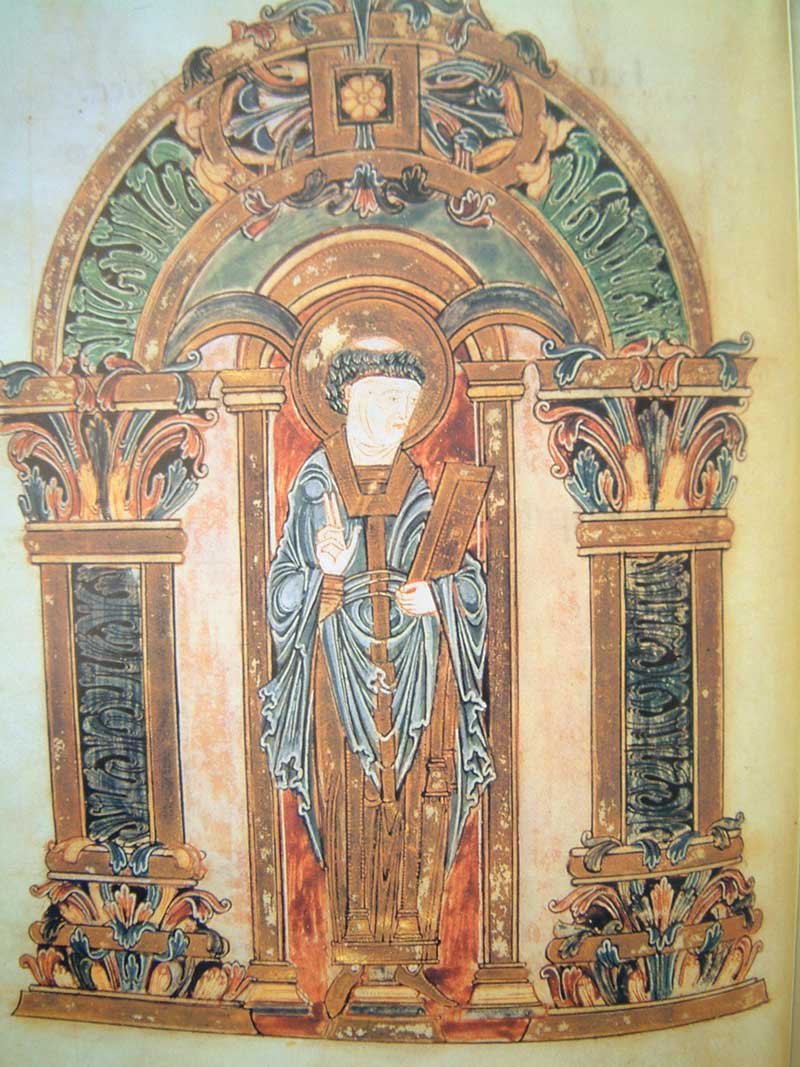BELOVED BISHOP SWITHUN WANTED TO LIE WHERE FEET WALKED AND RAIN FELL

[Above: Saint Swithim of Winchester from the Benedictional of St. Æthelwold—illuminated manuscript in the British Library / public domain, Wikimedia File:St-Swithin.jpg]
KING EGBERT (d. 839) of the West Saxons had as one of his principle advisors a Benedictine monk named Swithun. At least we think Swithun was a Benedictine. Little solid detail regarding him has survived into our day. One document that verifies his importance is a parchment that gives the church one tenth of the lands of Wessex for its support; his signature stands beside the king’s and another advisor’s. Most accounts declare that Swithun tutored the future king, Ethelwulf, father of Alfred the Great.
Acquaintance with kings has its advantages. When the see of Winchester came open, likely it was the king who tapped Swithun to fill the vacancy. Ceolnoth, Archbishop of Canterbury, consecrated him as bishop of Winchester in October 852. He became known for his humility, making his visitations on foot. When he had a church to dedicate, he even walked to it barefoot.
Exerting his authority for the benefit of ordinary people, Swithun had a stone bridge built over the Itchen River to make it easier for farmers to transport their produce to market. He also restored churches and had new church buildings erected so that more folk could benefit from the services of priests. Amid his projects, the bishop did not forget to assist the poor. And “his mouth was always open to invite sinners to repentance, and to admonish those who stood to beware of falling,” says Alban Butler, following Malmesbury’s account.
Swithun died on this day, 2 July 862. About a century later, his name began to be invoked in behalf of needed church reforms. Legends arose. One said that when a workman had rudely jostled a woman carrying eggs to market, causing her to drop her basket and break the produce she hoped to sell, Swithun had rebuked the workman and restored the eggs intact.
More famous and more probable is a legend that asserts he had asked to be buried where “passersby might tread on his grave and where the rain from the eaves might fall upon it.” Later, monks said Swithun appeared to them in a dream requesting his body be moved into a shrine inside the rebuilt church. At the time of the move, many miracles occurred, indicating the bishop’s sanctity. Supposedly, heavy rains also fell, causing superstitious folk to think the saint was actually displeased at being moved inside.
A folk saying emerged,
St. Swithun’s day if thou dost rain
For forty days it will remain
St. Swithun’s day if thou be fair
For forty days ’twill rain no more.
Swithun’s tomb became one of the most popular pilgrimage sites in England. In the gruesome practice of the day, pieces of his body were hacked off and loaned to other shrines. His head went to Canterbury and an arm to Peterborough Abbey. In 1538, Protestant reformers, who viewed veneration of saints as idolatry, destroyed Swithun’s Winchester shrine.
—Dan Graves





